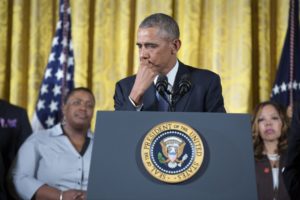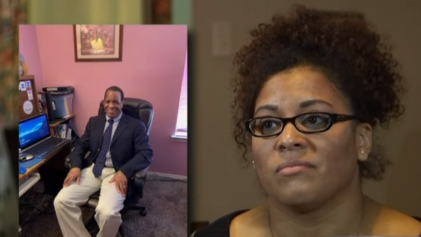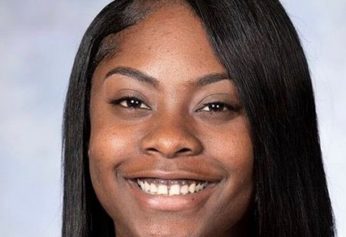
Former President Barack Obama tearing up while answering a question about what can be done to reduce gun violence. “We know that we can’t stop every act of violence. But what if we tried to stop even one?” the former president responded.
It is not too hard to find a story today about the relationship between the African-American community and guns. Typically, these stories paint a complicated and often inaccurate view of the role guns play in the lives of people of color.
For example, it was recently reported that a 15-year-old African-American boy was shot and killed May 6 by San Diego Police responding to a 911 call. The teenager allegedly pointed a BB gun at the police when they arrived. The police stated that the teenager who was shot made the original 911 call. In a separate report, a drunken gunman opened fire at an apartment pool in San Diego on April 30, targeting and killing African-Americans and a Hispanic. Yet, in another report, Austin police shot and killed a 24-year-old African-American man that is alleged to have fired at the police officers.
It is unclear what is going on here. For the most part, there is simply not enough information to make sense of the realities of the gun violence epidemic in the African-American community, which makes statements – such as Donald Trump’s assertion in his State of the Union address that the “cycle of poverty” is feeding the “cycle of violence” in cities like Chicago – inflammatory and unsustainable. Such statements ignore several key facts, such as the rate of Black victimization being a third today of what it was 20 years ago and that the regions with the most marked difference between Black and white victimization are not the major cities, but areas like Missouri, Indiana and Washington D.C.
“The truth of the matter is that we just don’t know what is behind the gun violence,” Nicholas Johnson, professor of law at the Fordham University’s School of Law, stated. “Every popular theory — from single-parent families to economic disparity to sheer boredom — either has been disproved or does not have enough evidence to support them.”
In light of what is being seen as a public health crisis and a changing reality of the role of guns in the African-American life, the conspiracy of silence that surrounds this issue is stifling. By understanding who is pushing this intentional ignorance and why, we can move forward toward understanding the true role of the gun in the Black community and build meaningful strategies to control its influence.
Understanding the Numbers
There is no denying that there is a gun problem in the African-American community. To understand the concerns, a look at the numbers is needed.
In 2015, the latest year to have full data released on firearm violence statistics, there were 12,979 gun-caused homicides. Approximately 59 percent (7,615) were African-Americans, with African-American men aged 34 or younger accounting for 39 percent of all of the firearm homicides in the United States. To put this in perspective, the 2015 Black homicide-by-firearm rate of 17.81 per 100,000 individuals is on par with Panama and Brazil’s national rates and would be the ninth-worst if the African-American community was recognized as its own country.
The Violence Policy Center’s analysis of the 2014 national homicide data showed that only 16 percent of all Black homicides are gang-related. Fifty percent of all Black murders arose from an argument that grew out of control and 72 percent involved a shooter that knew the victim.
Despite the high numbers, African-American gun violence is at a 30-year low, as is all violent crime in the United States. Most Americans are, however, unaware of this fact. This is in part due to media coverage of protests regarding police-related fatal shootings of unarmed Black men and children in Ferguson, Charlotte, Cleveland and New York City, and in part due to the oft-repeated and oft-disproven Republican mantra that African-Americans are responsible for the nation’s gun violence.
This was seen during the 2016 presidential campaign, when Trump claimed in an ad that 81 percent of white homicide victims were killed by Blacks. (The actual percentage is 15 percent; whites kill other whites 82 percent of the time.) He also tweeted that “inner-city crime is reaching record levels.” (There is no official category in any federal statistics for “inner-city crime” and for cities with populations over 250,000, there have been a sharp decline).
It should be noted, however, that there has been an uptick in the homicide rate in some of the larger cities since 2015, such as Orlando, Cleveland and Nashville. “The increase in crime in inner cities in 2015 was a large one-year increase, but you can see that the long-term trend is way down,” Alan Lizotte, a criminologist at the University at Albany, said to Politifact. “The recent spike would need to continue for a while to reach early-1990s levels.”
The Curious Tale of the Black Community and Gun Ownership
Nationwide, gun purchasing rates are dropping. The inconvenient truth with gun sales is that Democrats in control are very good for the bottom line. A fear of Democrats possibly restricting gun ownership rights tends to drive gun purchases. Under the united Republican government, a lack of ‘fear of missing out’ has dried up gun sales in almost every demographic.
That is, with the exception of African-Americans. The community’s gun-purchasing rate has skyrocketed since the election of Trump, mostly out of fear of an increase in racially motivated attacks and spiteful rhetoric from supporters of the president and the growth in the number of hate groups in the U.S.
Typically, the large number of guns that have entered the Black community have been “weapons of opportunities,” brought in through various third-parties in an extralegal manner. In 2014, for example, only 19 percent of Black households reported owning a gun, compared to 41 percent of non-Hispanic white households.
Legally owning a gun as an African-American wasn’t always an option. Law enforcement once regularly used race as a discriminating factor against issuing gun permits. Martin Luther King Jr., a gun owner, once famously applied for a concealed-carry permit in Alabama after his house was bombed in 1956. Despite being a member of the clergy, not having a criminal record at the time and having a demonstrable need for a firearm due to being threatened daily, the local police still denied his application on the basis of race.
Legally owning a gun does not protect the gun owner from the prejudices of those uncomfortable with an armed African-American, as well, as was the case with Philando Castile. Castile was a licensed gun owner who declared clearly that he had a lawful gun in his possession before being shot because of the gun.
This, however, undermines the reality that there is a growing subsection of African-Americans that have bought guns legally for their own protection, for sport or for the sheer sake of gun possession.
This subsection has grown rapidly since the election of Trump. Per CNN, for example, the National African-American Gun Association reported adding 9,000 members to its roster between Election Day 2016 and February 2017, up from 4,285 members added over the same period a year prior.
This growth reflects an unsettling fact that has been underreported: The rate of white-on-black killings is growing faster than the rate of black-on-white killings. A concern for personal safety has seen a spike in Black gun purchases, especially among African-American women, who makes up the largest percentage of the NAAGA’s newest members.
“Because of the climate in the White House … people in the African-American community and other communities are concerned about their safety,” Michael Cargill, a central Texas gun shop owner, told CNN. “I’m seeing people who want to learn how to shoot and then have us help shop for the right gun.”
“It’s something that I haven’t seen in years past.”
Monetizing Pain
The notion that there are guns in the African-American community is not a problem. The problem lies in who in the African-American community has the guns.
“Not every Black person is killing. The truth is, gun ownership is rare in the Black community, despite increases since the election of Trump,” Nicolas Johnson of Fordham’s School of Law adds. “As with any demographic group, there is a subset of the Black community that is antisocial. It may be financial frustrations or social stigmatization or mental illness or simply boredom, but something is driving these individuals to use their guns on each other. The trick is taking those guns away from them.”
In statistics showing recent spikes in Black homicides, those spikes have been driven by increases in street violence. Non-gang-related violence in these cities, similar to violent crime rates nationwide, has been on the decline.
A large component of the proliferation of illegal guns on the streets is the lack of effective control of gun trafficking. According to “Gun Violence in America: Informing Policy with Evidence and Analysis” by Daniel Webster and Jon Vernick, only 11 percent of the participants of the 2004 Survey of Inmates of State Correctional Facilities indicated that the guns recovered by the police for their criminal offense were purchased legally by the retailer from a licensed gun dealer. Sixty-seven percent of offenders indicated that their guns came from a friend or family member or from a street/black-market supplier.
In a large part, the proliferation of guns in this African-American community can be tracked to differences between local and state gun control regulations and trafficking between lenient and strictly regulated states. The proliferation of junk guns or cheap guns that can be secured easily by traffickers and sold at premium prices in restricted areas also play a role.
“Laws requiring private gun owners to promptly report theft or loss of firearms to police are intended to increase private gun seller accountability and provide law enforcement with a tool to combat illegal straw purchases when such purchasers accept no responsibility for the gun being in the hands of a prohibited person with dubious claims of unreported gun theft,” “Gun Violence in America” reads. “Having this measure of accountability significantly reduced interstate gun trafficking, as did bans of junk guns.”
Without effective gun control, weapons cannot be kept out of the hands of those that should never have access to guns. Worse, the quick availability of non-traceable weaponry offers a false solution at times of heightened passions where scarcity may lead to less-fatal solutions.
The Problem with Perceptions
The problem in this lies in the fact that maintaining the status quo tends to be more profitable. In regards to the gun situation in the African-American community, creating false equivalencies not only increase gun sales from those scared of the specter of Black violence but also creates a false narrative for those seeking to cultivate power based on fear.
“Donald Trump campaigned partly on the notion that our cities, at least some cities like Chicago and Baltimore, were out of control with gun violence and that he would be a law-and-order president who could staunch the violence,” noted Daniel Webster, author of “Gun Violence in America” and director of the John Hopkins Center for Gun Policy & Research. “Jeff Sessions was a close adviser to the campaign and selected to be Attorney General. Now that Trump is president and Sessions is his AG, one would think that high rates of gun violence in cities, if they do not decline under their tenure, will hurt them politically. “
“So, high rates of gun violence in cities, just like terrorist threats, helped with Trump’s political message as an outsider and change agent who wants to shake up the system. But now, Trump and Sessions have pressure to reduce gun violence in cities.”
The monetization of gun violence for political and monetary gains has created a blight on the health and prosperity of an entire people. Unless the effects of this are understood and recognized, the possibility of finding valid remedies may be just a dream.
“America has an intentional injury problem with firearm violence. It is a medical epidemic by any measure,” Georges C. Benjamin, executive director of the APHA, adds. “Clearly, the more fear we have, the more guns get bought and the gun dealers benefit from that. But, frankly, the whole community loses. Economic development, education and health are all negatively impacted by gun violence.
“We can invest in multi-sectorial solutions. Groups, such as Cease Fire in Chicago, have a methodology that focuses on violence as an infectious disease. This has been highly successful in reducing violence and it affects gun deaths,” he continued. “That, coupled with cracking down on bad-apple drug dealers, universal background checks and closing the gun show loophole, would help reduce the number of guns in the wrong hands without negatively impacting the second amendment.
“I think in a difficult environment like the one we are in we need to push even harder.”


